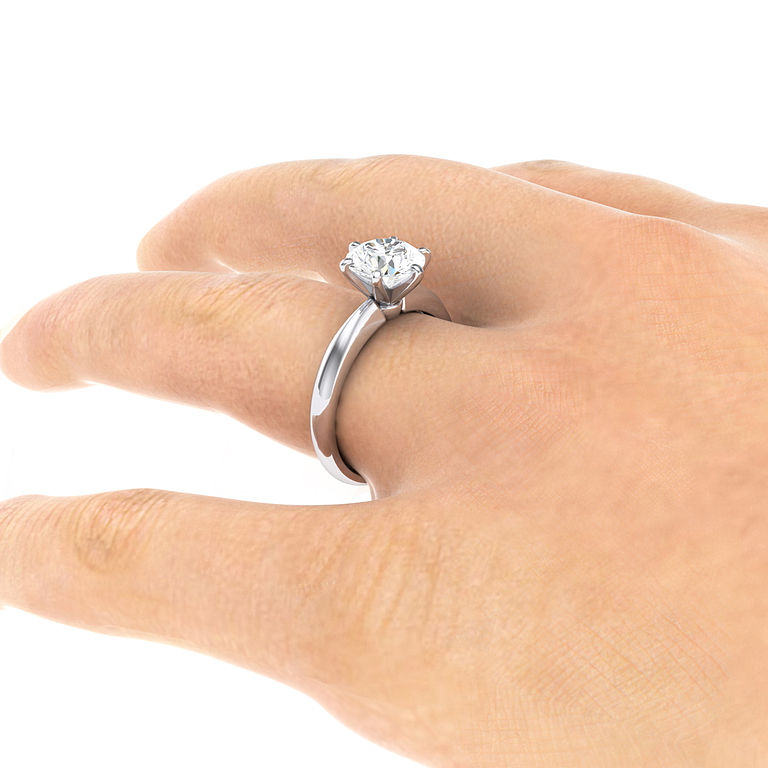Basic Diamond Proportions: The Hanneman Diamond Cut Grading System, Lesson Two
In the Hanneman cut grading system, you must consider diamond proportions to grade a round brilliant stone. Learn what they are and how to calculate them.
3 Minute Read
Basic Proportions
This is basic geometry, but stick with me.
In simple terms, consider a diamond to be composed of three components that fit together: a cone, cylinder, and frustum. (That's part of a cone-shaped solid next to the base, formed by cutting off the top with a plane parallel to the base). These shapes correspond to the pavilion, girdle, and crown of a cut diamond. The base of the cone forms the pavilion. The (very short) cylinder forms the girdle, and the base of the frustum forms the crown. All have exactly the same diameter.
Now, if you define the diameter, the crown angle and the pavilion angle, you can't define the size or shape of the object. This is because you've ignored the size of the girdle.
If you define the diameter, the crown and pavilion angles, and the girdle, you still can't define the size or shape of the object. You've ignored the height of the crown. However, if you define the diameter, the crown and pavilion angles, the girdle, and the crown height or total height, you've completely defined the size and shape of the object. For this reason, these measurements are used in cut grading to define the size and shape of the stone. In practice, you can consider the combination of all these measurements unique for each cut diamond.
The Ideal Cut
Over 100 years of diamond cutting has led to a consensus, except for the Gemological Institute of America (GIA). If you wish to produce a diamond recognized as having the best compromise between brilliance and fire, there are optimum values for each of these measurements. This optimum has been termed the "Ideal Cut." Of course, others have proposed many "ideal cuts." They stress brilliance, fire, or even economics by making minor alterations to things like table size. However, no one has seriously challenged the fact that the crown and pavilion angles are the keys to beauty.
The GIA claims no single set of diamond proportions produces the "best" cut for round brilliants. In this, they're mistaken. Granted, you'll never be able to demonstrate it, since our measuring systems aren't precise enough. Nevertheless, all the data, including the GIA's own monumental study, demonstrates an optimum set of diamond proportions. When the ratio of the crown angle to pavilion angle (C/P) has a value of 0.84, a diamond attains those proportions.
Calculating Diamond Proportions
As useful as that information is, as we said earlier, defining crown and pavilion angles isn't enough to define the shape and size of a stone. Every dimension has an effect. Now, we'll consider them.
The most critical measurements are crown height and girdle thickness. If you can measure them directly, fine, do so. However, you can get the same information another way. If you examine the certificates commonly found accompanying almost all diamonds in "lower end" jewelry stores, you'll find information such as diameter and total height or depth.
Again, years of diamond cutting have shown optimum girdle thickness can be considered to be 3% of the stone's diameter. Also, the total height or depth of the pavilion plus the height of the crown also has an optimum. That value is 57.3% of the diameter. Combining these values gives us: total height = 57.3 + 3%. This is the other equation needed in the Hanneman Cut Grading System.
Homework Assignment
- Using the information gathered for the stones in the homework assignment for lesson one, determine the C/P ratios and total height values for each of your samples.
- If you don't have the data to determine C/P, don't worry. We can make up some.
The Hanneman Diamond Cut Grading System Series
- Introduction, Lesson One
- Basic Proportions, Lesson Two
- Grading Categories, Lesson Three
- Evaluating the Cut, Lesson Four
William Hanneman
W. William Hanneman, Ph.D. is a retired research analytical chemist. Gemology is his hobby. He has authored several books, guides, and toolsets based on his unique chemistry based perspective on gemology.
Related Articles
Verdelite (Green Tourmaline) Buying Guide
Rubellite Tourmaline Buying Guide
Evaluating Gemstone Cutting: The Five Ps
Traditional Diamond Cut Grading Methods
Latest Articles
800 Years of Mogok: A Celebration in Tenuous Times
What is the Average Gemstone Faceting Yield?
Pyroxmangite Value, Price, and Jewelry Information
How to Identify Emerald Simulants and Synthetics
Never Stop Learning
When you join the IGS community, you get trusted diamond & gemstone information when you need it.
Get Gemology Insights
Get started with the International Gem Society’s free guide to gemstone identification. Join our weekly newsletter & get a free copy of the Gem ID Checklist!
